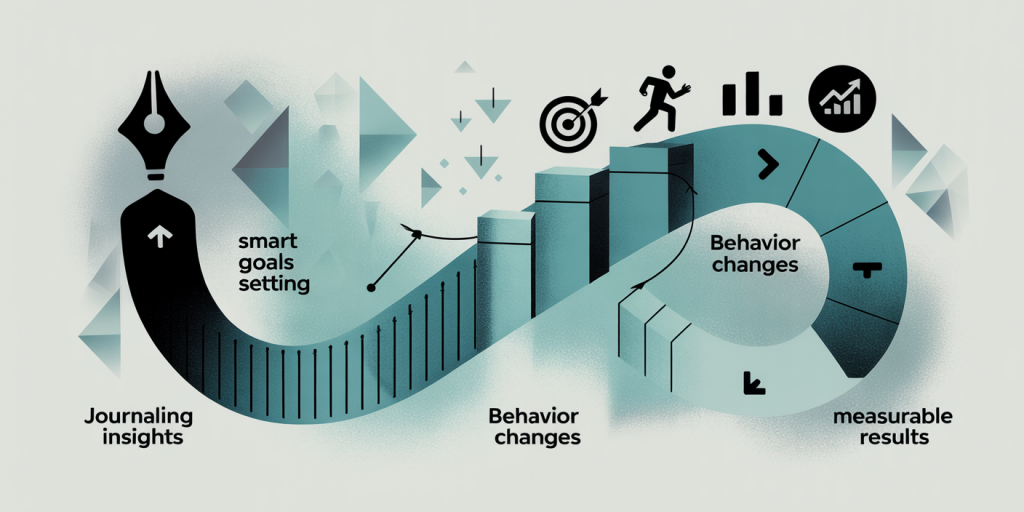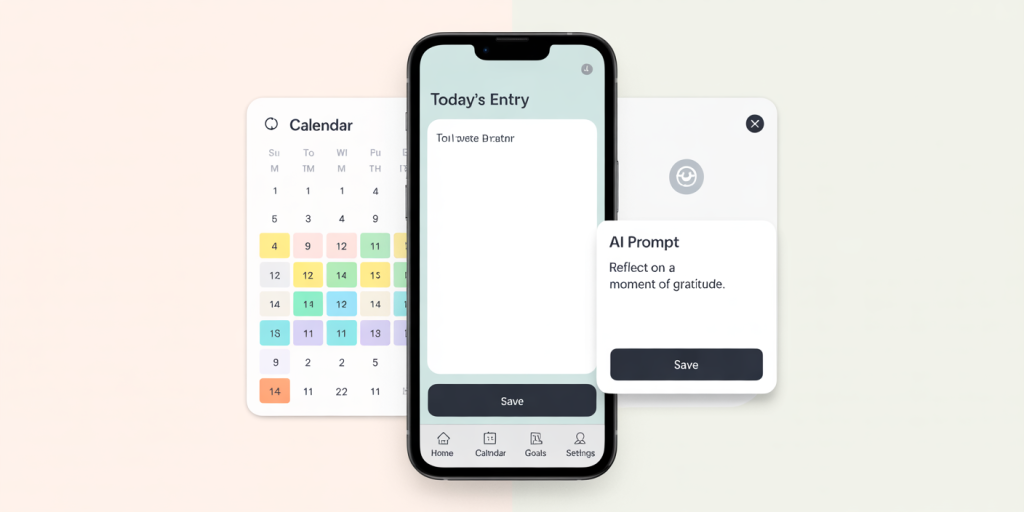From Journaling to Action: Turning Self-Reflection into Real Change
In today’s fast-paced world, self-reflection is more crucial than ever for personal growth and transformation. People across the globe are adopting journaling as a method to engage in introspection, aiming to better understand their thoughts, emotions, and behaviors. However, the true power of journaling lies not just in writing down reflections but in leveraging those insights to initiate tangible, positive change. This article explores the journey from journaling to action, providing practical methods and evidence-based strategies to convert self-reflection into meaningful results.

The Value of Journaling in Self-Reflection
Journaling serves as a powerful tool for enhancing self-awareness. According to a 2020 study published in the *Journal of Psychological Research*, expressive writing can reduce emotional distress by 34% and improve emotional processing abilities. By writing about one’s thoughts and experiences, individuals externalize internal dialogue, enabling clearer insights and emotional clarity.
For example, a professional facing career uncertainty might keep a daily journal to track their aspirations, fears, and recurring patterns of procrastination. Over weeks, this reflection can reveal hidden barriers or reveal new interests. Such journaling fosters mindfulness, allowing individuals to pinpoint specific areas of their lives requiring adjustment. However, while journaling initiates awareness, it alone does not guarantee change.
Bridging the Gap: From Awareness to Change
Anúncios
Awareness generated by journaling must trigger deliberate action to create real transformation. This gap is often where many stumble—reflecting continuously without altering behaviors or decisions. One practical approach is to set SMART goals (Specific, Measurable, Achievable, Relevant, Time-bound) based on journal insights. For instance, if journaling reveals morning lethargy hampers productivity, a goal might be: “Wake up at 6:30 AM every weekday for one month and engage in 10 minutes of stretching.”
Anúncios

A notable case is that of Sarah, a marketing manager in New York, who used journaling to address chronic stress. Sarah recorded daily triggers and reactions, which clarified her need to delegate tasks better. By setting clear goals around delegation and regularly reviewing her journal’s entries, she experienced a 25% reduction in stress levels over three months, validated by both her perceived wellbeing and wearable stress-monitor data. This demonstrates that intentional changes, motivated by journaling, can have measurable effects.
| Journal Insight | Action Taken | Result Achieved |
|---|---|---|
| Frequent stress from heavy workload | Delegate at least 30% of tasks | 25% reduction in perceived stress |
| Procrastination during afternoons | Scheduled focused 30-min work blocks | Increased afternoon productivity by 40% |
These examples reveal the importance of journaling as a diagnostic phase, followed by effective planning and concrete steps to alter habits and outcomes.
Techniques to Translate Reflection into Behavior
To make journaling an actionable practice, individuals can adopt various techniques that support behavioral change. One evidenced approach is “implementation intentions,” which involve planning the “when, where, and how” of actions inspired by journal insights. Research by psychologist Peter Gollwitzer found that people who employ these specific plans are twice as likely to follow through on intentions.
For example, someone reflecting on feelings of social isolation may write: “If I feel lonely after work, then I will call a friend or attend a weekly meetup group.” This precise format strengthens commitment and prepares the mind to act when cues arise.
Another valuable strategy is using journaling as a feedback loop. After setting goals, daily or weekly journal entries should include reflections on progress, barriers, and adjustments needed. According to a 2019 study published in *Behavioral Science*, self-monitoring combined with reflective journaling significantly improved goal attainment by 30%, compared to monitoring alone.
Consider Maya, a university student wanting to improve study habits. Each day, she journals how many hours she studied, distractions encountered, and feelings towards the material. She reviews her journaling weekly to refine study techniques and schedules, resulting in a GPA increase from 3.1 to 3.7 over two semesters. Such iterative reflection-action cycles showcase how journaling becomes a dynamic tool for continuous improvement.
Overcoming Common Challenges in Moving from Journaling to Action
Despite its benefits, many encounter barriers when transitioning from journaling to concrete change. A prevalent challenge is “analysis paralysis,” where excessive reflection leads to indecision. This is often due to perfectionism or fear of failure. To combat this, cognitive-behavioral approaches suggest limiting journaling sessions to defined time slots and focusing on actionable insights rather than exhaustive introspection.
Another obstacle involves inconsistent journaling habits that disrupt momentum. According to a survey by *Psychology Today*, 40% of journalers stop within the first month, mainly due to lack of immediate results or motivation. Setting micro-habits, such as journaling at the same time daily or pairing journaling with an enjoyable ritual (e.g., tea or background music), can reinforce consistency.
Furthermore, emotional discomfort arising from confronting painful truths can deter action. Techniques like self-compassion journaling, where individuals write with kindness and understanding toward themselves, help reduce this resistance. Research from the *Self and Identity Journal* indicates that people practicing self-compassion show higher resilience and greater likelihood to pursue change despite setbacks.
| Challenge | Recommended Strategy | Supporting Evidence |
|---|---|---|
| Analysis paralysis | Time-limited journaling sessions | Studies on decision fatigue (Baumeister, 2014) |
| Inconsistent journaling habits | Create micro-habits and triggers | *Psychology Today* 2021 survey |
| Emotional resistance | Self-compassion journaling | *Self and Identity Journal*, 2022 study |
By understanding these common hurdles and implementing targeted strategies, individuals can maintain the momentum needed to translate reflection into action.
Case Studies Demonstrating Effective Journaling-to-Action Transitions
Real-world cases provide illustrative examples of how journaling can lead to meaningful outcomes. James Clear, author of *Atomic Habits*, credits journaling as a fundamental step in habit formation. His method involves tracking habits, noting triggers in his journal, and adjusting routines based on daily reflections. This systematic approach helped him build behaviors like daily writing and consistent exercise, which contributed to his widespread success and productivity.
Similarly, Tiffany, a corporate executive, journaled her struggles with work-life balance. Noticing from her entries that evenings were consumed by low-value tasks, she implemented delegation and time-blocking strategies. Over six months, her journal reflected increased family time and decreased burnout symptoms. Tiffany’s story aligns with data by the *American Psychological Association* that shows time management interventions can reduce burnout risk by 20%.
Another poignant example is a therapeutic case where a client named Leo used expressive journaling to cope with trauma symptoms. Encouraged by his therapist, Leo wrote freely about his experiences and then developed coping strategies such as grounding techniques and support-seeking behaviors. Over one year, self-report scales indicated a 40% decrease in PTSD symptoms, reinforcing how journaling combined with action plans serves as a therapeutic tool.
These diverse cases show that journaling is not a standalone solution but a catalyst that, when paired with goal setting, planning, and perseverance, fosters transformation.
The Role of Technology in Enhancing Journaling and Follow-Up Actions
Modern technology increasingly supports journaling and its evolution into action. Digital journaling apps like Day One and Journey offer features such as reminders, mood tracking, and integration with goal-setting tools, which encourage regular reflection and follow-up.

Studies highlight that these digital platforms lead to higher compliance rates: a 2022 survey by *MindTech Research* found that 65% of users maintained daily journaling habits for longer than six months using apps versus 35% with paper journals. The apps’ ability to sync across devices and provide analytics empowers users to identify patterns and make informed decisions.
Moreover, some applications incorporate AI-driven prompts to deepen reflections or suggest personalized action steps. For example, a user noting frequent anxiety triggers might receive tailored mindfulness exercise recommendations. These innovations bridge the gap between insight and intervention.
The table below summarizes the advantages of traditional versus digital journaling tools in converting self-reflection into actionable change:
| Feature | Traditional Journaling | Digital Journaling |
|---|---|---|
| Accessibility | Limited to physical journal | Accessible on multiple devices |
| Reminders & Notifications | Requires manual self-discipline | Automatic reminders improve consistency |
| Data Analysis & Tracking | Manual review | Automated insights track mood, habits |
| Actionable Prompts | Self-generated | AI-driven or app-suggested steps |
| Privacy & Security | More control but susceptible to loss | Secure encryption, but potential hacking risk |
Leveraging technology smartly enhances the journaling experience and increases the likelihood of converting reflection into sustained change.
Future Perspectives: Evolving Practices for Deeper Impact
Looking ahead, the integration of journaling with psychological sciences and technology promises more personalized pathways to change. Emerging research explores using biosensors combined with journaling to deepen awareness. For example, pairing heart rate variability monitors with journal entries allows users to connect physiological states with emotional experiences, facilitating precise interventions.
Furthermore, virtual reality (VR) environments could revolutionize reflective practices by immersing individuals in scenarios drawn from journal content, enabling experiential learning and behavioral rehearsal. This method could accelerate habit formation and emotional processing beyond traditional writing methods.
Artificial intelligence advancements will increasingly tailor prompts and action plans, using natural language processing to analyze journal entries and suggest bespoke growth techniques. This augments existing cognitive-behavioral therapies and coaching methodologies.
In workplaces, employers may adopt journaling platforms to boost employee wellbeing and creativity, recognizing that reflection-driven change enhances productivity and organizational culture. As such, journaling could become a standard tool embedded in professional development frameworks.
Finally, growing awareness of diversity and inclusivity will shape journaling methods to accommodate varied cultural perspectives and individual differences, promoting holistic and equitable growth opportunities.
From a simple practice of writing to unlocking profound shifts in mindset and behavior, journaling offers a pathway from introspection to real-world change. When accompanied by strategic goal setting, action planning, and adaptive tools, reflective writing transforms passive insight into active transformation. By embracing emerging technologies and informed techniques, individuals can harness journaling’s full potential, fostering continual growth in an ever-changing world.
